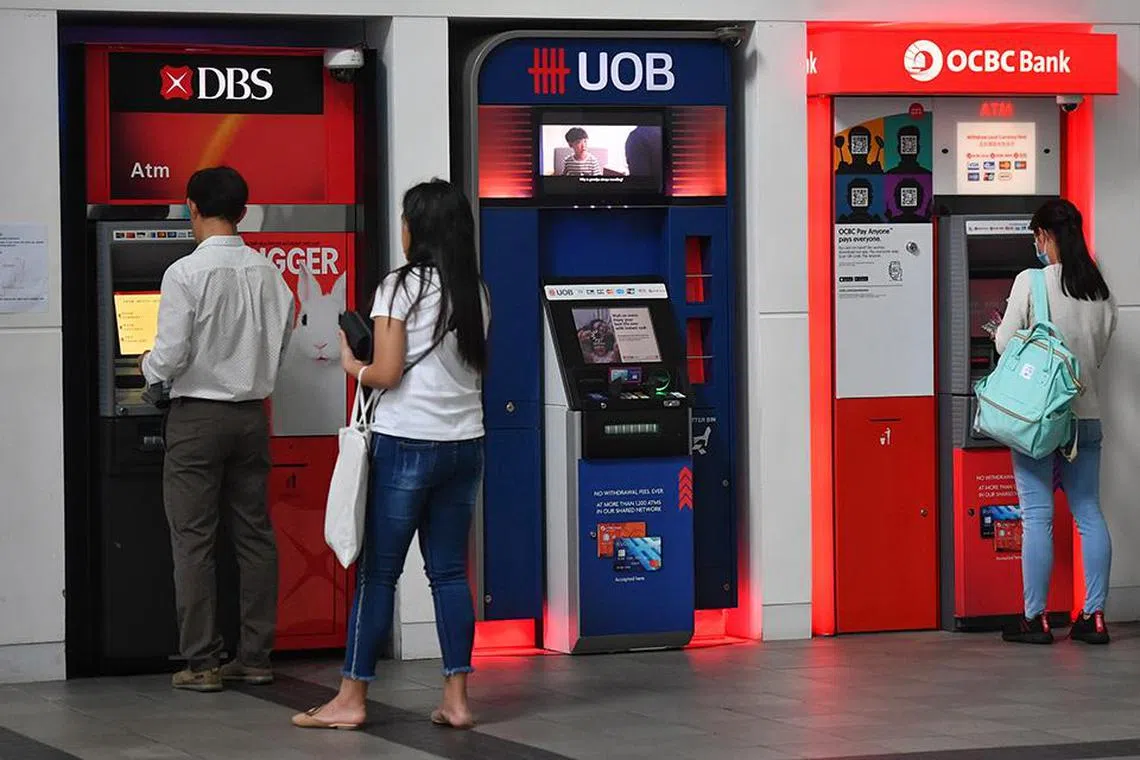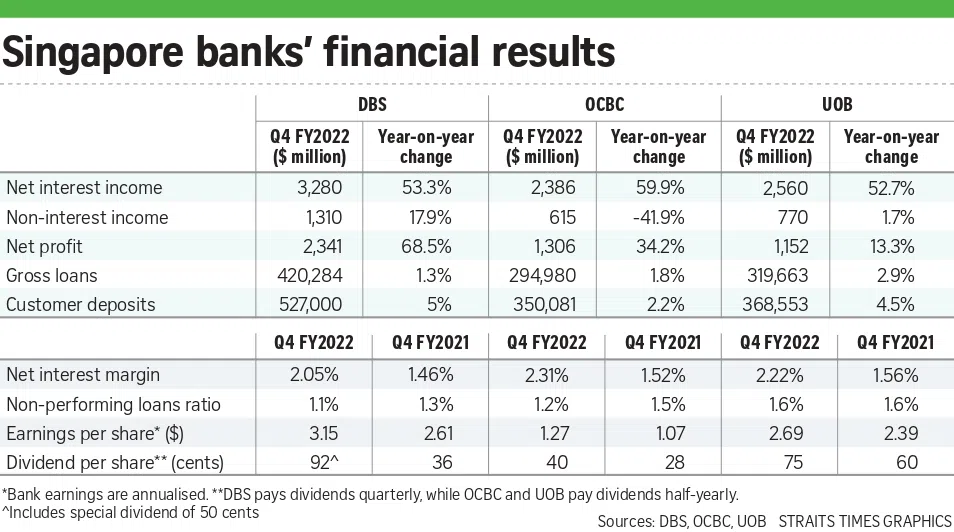S’pore banks face slowing loan growth, higher credit costs in 2023 but outlook still bright
Sign up now: Get ST's newsletters delivered to your inbox

Net profits for DBS, UOB and OCBC for the fourth quarter of 2022 surged as a result of higher interest rates.
PHOTO: ST FILE
Follow topic:
SINGAPORE – The three local banks face a continued slowdown in loan growth and higher credit costs in 2023 but their earnings will stay buoyant, analysts told The Straits Times.
Last week marked the end of the results season for DBS Bank, OCBC Bank and UOB, which saw their net profits for the fourth quarter between October and December 2022 surge as a result of higher interest rates.
Still, rising rates also weighed on demand for loans and brought more competition for customer deposits – a cheap source of funds for banks – as people sought higher yields elsewhere.
After eliminating the impact of foreign exchange rate fluctuations, the loan books grew by 4 per cent year on year at DBS, 4.5 per cent at OCBC and 5 per cent at UOB.
These growth figures are largely in line with what the lenders had targeted for 2022, but mark a loss of steam compared with the 8 per cent to 10 per cent growth seen in 2021 during the pandemic.
Loan growth is expected to slow further in 2023. Ms Tania Gold, Fitch Ratings’ head of South and South-east Asian banks, expects only a 1 per cent increase in loans for the 2023 financial year as slower economic growth dampens demand.
But even with limited loan growth, the lenders’ profits should continue to increase due to the higher interest rates, she said.
The banks attributed the decline in fourth-quarter loan growth to customers repaying their loans instead of taking up new ones, and not a lack of demand, noted Ms Gold.
They expect their loan books to see mid-single-digit growth in 2023.
While the quantum of United States rate hikes has been tapering,
Phillip Securities research analyst Glenn Thum said there is a lag before the impact of tapering rate hikes reaches the local banks.
“I don’t think we will see a dip in NIM (net interest margin) in the first two quarters. It will stay at an elevated rate of at least 2 per cent and might even hit higher than what the banks were guiding for the first two quarters, before moderating in the second half,” he said.
NIM represents the difference between the interest income generated by loans and investments, and the interest expense paid on customer deposits.
Mr Thum added that the banks’ higher net interest income and NIM should more than offset a slowdown in loans.
“Loan growth levels will maintain in the coming quarter and pick up slightly in the rest of the year, more in the second half,” he said.
Maybank head of research Thilan Wickramasinghe said China’s reopening and Asean supply chain developments should accelerate credit demand.
“Despite Singapore’s latest property cooling measures – which seem to be aimed primarily towards higher-end properties – mortgage demand should also see support from mass-market launches,” he added.
Fee income from the banks’ wealth management businesses is also expected to see double-digit growth in 2023 from a low base.
Mr Wickramasinghe said all three banks grew their net assets under management in 2022 despite market headwinds.
“An improving market outlook could see clients prepared to take on more risk, which should translate to these assets being deployed towards higher fee-generating activities.
“Also, (the banks’) investments in technology, especially in more targeted product offerings, should improve yields in mass-market wealth management products going forward,” he said.
But lenders will have to be watchful as funding costs catch up with them, and keep a close eye on asset quality and expenses.
The banks have been trying to lower such costs by attracting fixed deposits, noted Mr Thum.
Mr Wickramasinghe said higher interest rates and input costs could put a strain on companies’ income statements, especially those of small and medium-sized enterprises.
“Concurrently, slowing demand due to recessionary headwinds can further (put pressure on) profitability. These collectively raise asset quality risks for banks. Increasing non-performing loans (NPLs) and higher provisioning are risks to watch,” he said.
Still, the banks’ sizeable general provision reserves will help them mitigate adverse impact on their earnings if rising interest rates reduce borrowers’ repayment capacity, said Ms Gold.

Singapore lenders’ fourth-quarter NPL ratios improved or remained constant from a year ago. DBS and UOB wrote back, or restored to profit, general allowances previously set aside for potential bad loans, while OCBC set aside $213 million more of such allowances to buffer against uncertainties.
Mr Thum noted that the banks’ expenses have increased due to tech-related costs and salary bumps to retain staff, adding: “That’s something else they’ll have to keep in check.”
DBS shares fell 0.17 per cent to $34.34 on Monday, while OCBC climbed 0.24 per cent to $12.70 and UOB edged up 0.3 per cent to $29.94.


